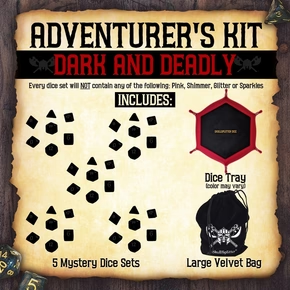
DND 5e Weapons
DND 5e Martial Weapons
Martial weapons take a bit more knowhow to use correctly, barbarians, fighters, paladins, and rangers, are proficient with all martial weapons. Most other classes get a couple specific martial weapon proficiencies, and warlocks can essentially get all melee martial weapons if they choose the pact of the blade. Martial weapons includes: battleaxes, flails, glaives, greataxes, greatswords, halberds, lances, longswords, mauls, morningstars, pikes, rapiers, scimitars, shortswords, tridents, warhammers, war picks, warhammers, whips, blowguns, hand crossbow, heavy crossbows, longbows, and nets.
Table of Contents:

How Can I Get Proficiency?
The main way to gain weapon proficiency is from your class. Though depending on your class, you might not get the weapon proficiencies you're looking for. If you're willing to take a level dip, a level of barbarian, fighter, paladin, or ranger will give you access to all martial weapons.
If you're not looking for a multiclass, you can also get some specific weapon proficiencies from your race. High Elves, Wood Elves, Drow, and every type of Dwarf all get some extra weapon proficiencies right from the start. Want to swing a battleaxe at the dragon as a wizard? Dwarven wizards can do that right from the start (plus some tasty poison saving throw resistances).
If all other options are off the table, you can always take a feat. The weapon master feat gives you proficiency in any 4 weapons of your choice. A feat is a big cost, but the option is there if all else fails.

So... What Weapon do I pick?
There's a ton of differences between weapons, but the most fundamental distinction is between melee and ranged weapons.
Every weapon is classified as either melee or ranged. A melee weapon is used to attack a target within 5 feet of you, whereas a ranged weapon is used to attack a target at a distance.
When you attack with melee weapons, you get to add your Strength modifier to attack and damage rolls UNLESS it has the "finesse" property. If it has the finesse property you can use dex instead of strength.
When you attack with ranged weapons, you get to add your Dexterity modifier to attack and damage rolls.
Beyond choosing between melee and ranged, weapons all have a whole slew of weapon qualities, including: Ammunition, Finesse, Heavy, Light, Loading, Range, Reach, Special, Thrown, Two-Handed, and Versatile.
Ammunition: Most DMs will just kind of hand-wave away your ammo, but in case they don't, weapons with the ammunition quality use up ammo as you use them. Arrows, bolts, bullets, they all cost gold and you technically need to keep track of it. Generally, don't worry about it.
Finesse: When you make an attack with a finesse weapon, you use your choice of your Strength or Dexterity modifier for the attack and damage rolls. You must use the same modifier for both rolls.
Basically, what this means is that with a finesse weapon, your Dexterity based character can get into melee just like a Strength based character. Especially consider rapiers, they're great.
Heavy: Small creatures have disadvantage on attack rolls with heavy weapons. A heavy weapon's size and bulk make it too large for a Small-sized creature to use effectively. Essentially, your gnome character is going to have a hard time swinging the greatsword that's twice as tall as they are.
Light: A light weapon is small and easy to handle, making it ideal for use when fighting with two weapons.
We'll come back to these when we talk about dual wielding.
Loading: Because of the time required to load this weapon, you can fire only one piece of ammunition from it when you use an action, bonus action, or reaction to fire it, regardless of the number of attacks you can normally make. This is a restriction limits crossbows and firearms, I recommend taking a look at the crossbow expert feat if you want to build your character around loading weapons.
Range: A weapon that can be used to make a ranged attack has a range in parentheses after the ammunition or thrown property. The range lists two numbers. The first is the weapon's normal range in feet, and the second indicates the weapon's long range. When attacking a target beyond normal range, you have disadvantage on the attack roll. You can't attack a target beyond the weapon's long range.
Special: A weapon with the special property has unusual rules governing its use, explained in the weapon's description.
This is the catch-all for weird effects like nets, make sure to read up on a weapon's special properties before using it.
Thrown: If a weapon has the thrown property, you can throw the weapon to make a ranged attack. If the weapon is a melee weapon, you use the same ability modifier for that attack roll and damage roll that you would use for a melee attack with the weapon. For example, if you throw a handaxe, you use your Strength, but if you throw a dagger, you can use either your Strength or your Dexterity, since the dagger has the finesse property.
This is a good way for a Strength-based character to get a little bit of range, consider taking some hand axes or javelins for your next barbarian.
Two-Handed: This weapon requires two hands when you attack with it.
For the most part, this is a tax on higher damage output weapons. Using both your hands for your weapon means you can't use on holding a shield, or another weapon.
Versatile: This weapon can be used with one or two hands. A damage value in parentheses appears with the property-the damage when the weapon is used with two hands to make a melee attack.
This is another tradeoff between extra damage and a shield, just like two-handed weapons, but with versatile weapons, you can easily switch it up.
5e Reach Weapons: This weapon adds 5 feet to your reach when you attack with it, as well as when determining your reach for opportunity attacks with it.
I wanted to emphasize this weapon property because of just how useful it is. Having a weapon with reach can be a HUGE advantage. In a lot of situations, you can make attacks from afar, then retreat unscathed. Or attack from behind a tanky ally without getting attacked back in return.
DND 5e Dual Wielding / Two-Weapon Fighting
Unlike many other systems, there really aren't any prerequisites to dual-wielding in 5e, you can just do it. The limits are set on what weapons you can use while you're dual-wielding. If you want to fight with a weapon in each hand, they both need to be " one-handed " weapons, which makes perfect sense. They also both need to have the " light " weapon quality. Clubs, daggers, handaxes, light hammers, scimitars, and shortswords all meet these requirements. Whenever you make an attack with one of these weapons, you get to use your bonus action to make an attack with the weapon in your other hand. There is a small downside though, you don't get to add your ability modifier to that bonus attack.
Wait, No Katanas?
You won't find katanas, or cutlasses, nunchucks or any number of exotic weapons within those lists of simple and martial weapons. That doesn't mean you can't wield them though. 5e kept the weapon options simple, rather than have a massive collection of slightly different swords. If you're dead set on a specific weapon, you can reskin one of the existing weapons with your specialty weapon. The statistics for a longsword can easily take the role of a katana, the statistics for a scimitar work well for a cutlass, Etc.
How do you calculate a hit in D&D?
Hitting in 5e doesn't take too many calculations, and the ones you do need to make are sort of baked in and won't be changing much from one attack to another. For the most part, you can perform the following steps once for any given weapon or type of attack, then simply save that number and use it whenever you take a swing.
Step 1: Are you proficient with the weapon?
Check if you are proficient with whatever weapon you're using. Many classes will grant proficiency with all simple or martial weapons, or they may provide only a selection of specific weapons. Races occasionally also grant proficiency in certain weapons.
If you are proficient with the weapon, you get to add your proficiency bonus to making your attack. Proficiency bonus is determined by level, and you can find it on your class table.
Step 2: Add the Appropriate Ability Modifier
Melee weapons will add your Strength modifier, ranged weapons will add your Dexterity modifier, and spells will use whatever ability is utilized in your spellcasting (Intelligence for Wizards, Wisdom for Clerics, Etc.).
There are some melee weapons with a special property called finesse, these weapons get to use your Dexterity modifier instead of Strength despite being melee weapons.
Similarly, you can make ranged attacks using your Strength modifier using weapons with the thrown property.
Once you figure out what ability score you're adding, simply add that to the total while making your attacks.
Step 3: Find Any Class Bonuses
Some classes will get a bonus to their attack rolls using certain Attacks. Check your class and determine if you have any of these bonuses, add them to the total while making attacks if they apply.
Step 4: Magic Weapon Bonuses
If you're lucky enough to have a magical weapon, they often have a bonus to their hit rolls. If you are wielding such a weapon be sure to add that bonus when making your attack roll.
Step 5: Add It All Together
Now we simply add all of this together to find our total bonus to our attack roll. For example:
Kurt is a 3rd level human ranger with a Dexterity score of 16, making an attack with a +1 magical longbow, Kurt picked "archery" as his fighting style and is proficient with longbows.
- Proficiency is +2 at 3rd level, so we get +2.
- 16 Dexterity provides a +3 modifier, so we get +3.
- The "archery fighting style" provides a +2 bonus to ranged weapons, so we get +2.
- It's a +1 magic bow, so we get +1.
- (2 + 3 + 2 + 1 = 8) So our total attack bonus is +8.
That total isn't going to change often either, so it's a good idea to write that down and save yourself from doing all these steps in the future.
Step 6: Make the Attack!
Now to actually make the attack roll. Simply roll a d20 and add your total attack bonus to get the result. If your attack roll equals or exceeds the AC of your target, you hit! Also be sure to note if you roll a natural 20 on that d20, because that hit is a critical hit and you'll get to double all your damage dice when resolving the attack.
How do I enchant weapons in D&D 5e?
The short answer is that you either play an Artificer or you don't. Artificers are a class specifically built around enchanting and crafting magical items, and it's quite time consuming for everybody else. It's up to DM discretion what exact items you can craft, but it does lay out the time and gold costs associated with them, for example, crafting an uncommon magic item or bestowing an uncommon enchantment would cost 500 gp and take 20 days of work. You can find the exact rules for item enchantment in the dungeon master's guide.
Enjoy this Guide? You May Also Like:
Thinking about other classes? Check out our giant list of D&D 5e Tools and Tips here.
Hungry for Adventure? Your group will love these D&D Game Night Snack Recipes
Need New Dice? Check out our Polyhedral Dice here.
New to find a D&D Group? Check out our guide on How to Find a D&D Group.

Disclaimer
Last updated: January 27, 2019
The information contained on www.SkullSplitterDice.com website (the "Service") is for general information purposes only.
www.SkullSplitterDice.com is a participant in the Amazon Services LLC Associates Program, an affiliate advertising program designed to provide a means for sites to earn advertising fees by advertising and linking to Amazon.com. (source: Section 5)
Blueshift Nine, LLC assumes no responsibility for errors or omissions in the contents on the Service.
In no event shall Blueshift Nine, LLC be liable for any special, direct, indirect, consequential, or incidental damages or any damages whatsoever, whether in an action of contract, negligence or other tort, arising out of or in connection with the use of the Service or the contents of the Service. Blueshift Nine, LLC reserves the right to make additions, deletions, or modification to the contents on the Service at any time without prior notice.
Blueshift Nine, LLC does not warrant that the Service is free of viruses or other harmful components.
Affiliate disclaimer
This affiliate disclosure details the affiliate relationships of Blueshift Nine, LLC with other companies and products.
Some of the links are "affiliate links", a link with a special tracking code. This means if you click on an affiliate link and purchase the item, we will receive an affiliate commission.
The price of the item is the same whether it is an affiliate link or not. Regardless, we only recommend products or services we believe will add value to our readers.
By using the affiliate links, you are helping support the Service, and we genuinely appreciate your support.
Affiliate advertising programs that the Service uses are:
- Amazon Services LLC Associates Program
- As an Amazon Associate, I earn from qualifying purchases.
- Blueshift Nine, LLC is a participant in the Amazon Services LLC Associates Program, an affiliate advertising program designed to provide a means for sites to earn advertising fees by advertising and linking to Amazon.com or endless.com, MYHABIT.com, SmallParts.com, or AmazonWireless.com.
- Pages on this Service may include affiliate links to Amazon and its affiliate sites on which the owner of this Service, Blueshift Nine, LLC, will make a referral commission.


